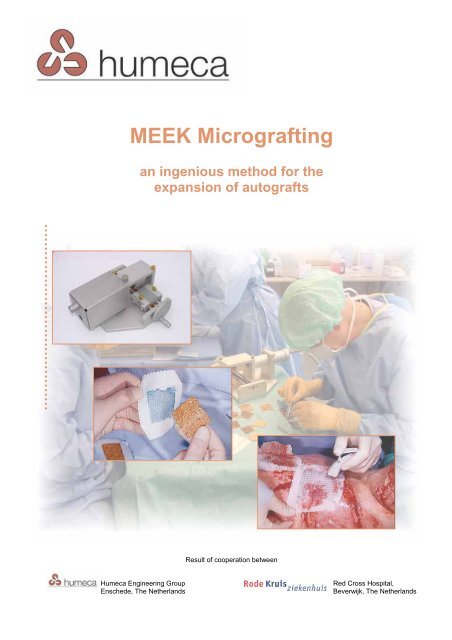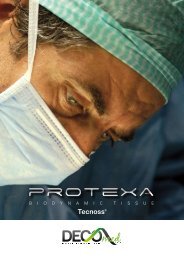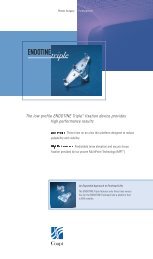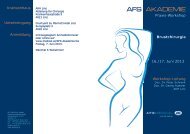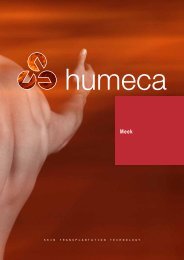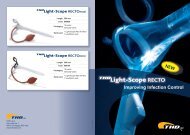MEEK Micrografting - AFS Medical
MEEK Micrografting - AFS Medical
MEEK Micrografting - AFS Medical
Create successful ePaper yourself
Turn your PDF publications into a flip-book with our unique Google optimized e-Paper software.
<strong>MEEK</strong> <strong>Micrografting</strong><br />
an ingenious method for the<br />
expansion of autografts<br />
Result of cooperation between<br />
Humeca Engineering Group<br />
Enschede, The Netherlands<br />
Red Cross Hospital,<br />
Beverwijk, The Netherlands
The <strong>MEEK</strong> technique<br />
In 1958 a remarkable technique<br />
for expanding autografts was<br />
described by the American<br />
surgeon C.P. Meek 1,2) . With a<br />
so-called ‘<strong>MEEK</strong>-WALL’<br />
dermatome postage stamp<br />
autografts were obtained and<br />
expanded with a ratio 1:9 using<br />
double pleated gauzes. The<br />
method however required too<br />
much skill and it became<br />
eclipsed by the introduction of<br />
mesh skin grafts by Tanner in<br />
1964. Eventually the <strong>MEEK</strong><br />
technique was discontinued.<br />
However, lack of autograft<br />
donorsites is still encountered as<br />
a limiting factor in achieving<br />
wound closure in case of<br />
extensive burns. The meshgraft<br />
technique requires donorsites of<br />
suitable size and shape and<br />
epithelialization may be delayed<br />
in case of expansion ratios<br />
greater than 1:4.<br />
<strong>MEEK</strong> surgery<br />
Besides, widely expanded<br />
meshed autografts might<br />
become too fragile and<br />
unmanageable.<br />
That’s why Humeca re-designed<br />
the <strong>MEEK</strong> method.<br />
Imperfections of the original<br />
technique were overcome. A<br />
sprayable adhesive was<br />
introduced and the <strong>MEEK</strong><br />
gauzes are now available with<br />
expansions 1:3, 1:4, 1:6 and 1:9.<br />
The clinical results with this<br />
modified <strong>MEEK</strong> technique, as<br />
first described in 1993 by Kreis<br />
et.al. 3,4) , are excellent. Graft take<br />
appears to be superior to other<br />
methods, especially in<br />
problematic zones and in case of<br />
qualitatively inferior wound beds.<br />
Only very small donorsites are<br />
required. Any small piece of the<br />
patients skin can be used. The<br />
graft islands are close together<br />
in a regular pattern.<br />
On the average the required<br />
donorsite surface in the <strong>MEEK</strong><br />
technique is about half of the<br />
surface required with meshgraft.<br />
Epithelialization and hospitalization<br />
times are reported to be<br />
shorter 7) . As the graft islands<br />
are not mutually connected,<br />
failure of a few islands does not<br />
necessarily affect the overall<br />
graft take. The cosmetic results<br />
are reported to be comparable to<br />
those obtained by meshing 1:3.<br />
The modified <strong>MEEK</strong> method for<br />
skin transplantation appears to<br />
be a simple technique to achieve<br />
a regular distribution of postage<br />
stamp skin grafts, correctly<br />
orientated to the wound surface.<br />
Encouraging results are reported<br />
in combinations of the <strong>MEEK</strong><br />
technique with other methods for<br />
wound healing in burns, like<br />
dermal generating templates 14,15)<br />
and cell spraying methods.<br />
A 42x42 mm cork plate... …is covered with a piece Also small graft pieces can The graft is cut into 196<br />
of split skin autograft. be used to cover the plate. 3x3 mm squares.<br />
2
After the epidermal side of graft is sprayed with an adhesive,<br />
the graft is transferred to the prefolded polyamide gauze.<br />
The cork plate is gently removed,<br />
leaving the graft islands on the gauze<br />
Expansion is realized by unfolding the gauze, first in one direction…<br />
…and then in the other direction<br />
At operation wounds to be<br />
grafted are excised down to the<br />
underlying fascia and<br />
haemostasis is secured. A<br />
square piece of cork measuring<br />
42x42 mm is covered with a split<br />
skin autograft, dermal side<br />
down. Smaller graft remnants<br />
are also suitable by placing them<br />
on the cork plate like a ‘puzzle’.<br />
The cork, covered with graft, is<br />
then placed in a special cutting<br />
machine that contains 13 circular<br />
blades. The cork plate with the<br />
graft on it is passed through the<br />
machine, where the rotating<br />
blades cut through the graft, but<br />
not through the cork. Thus the<br />
graft is cut into 14 stripes, 3 mm<br />
wide.<br />
After the first pass, the cork is<br />
rotated 90° and passed through<br />
the machine once more, thus<br />
cutting the graft into 14x14 = 196<br />
square pieces of 3x3 mm.<br />
The epidermal surface of the<br />
graft is then sprayed with an<br />
adhesive and allowed to dry and<br />
become tacky. The cork plate,<br />
covered with graft is pressed<br />
onto a prefolded polyamide<br />
gauze, which is folded on an<br />
aluminium foil backing into<br />
14x14 square pleats, the size of<br />
which corresponds to the size of<br />
the cuts in the graft. Then the<br />
cork is gently removed, leaving<br />
the graft islands on the gauze.<br />
The gauze is pulled out by firm<br />
traction on all four sides, until the<br />
pleats become entirely unfolded.<br />
Finally the aluminium backing is<br />
peeled off, leaving the expanded<br />
gauze with the separated autograft<br />
islands ready for grafting.<br />
After trimming the margins, or<br />
folding them double down, the<br />
gauze is applied, graft side<br />
down, to the wound bed and<br />
secured with surgical staples.<br />
After about 6 days the grafts<br />
have grown sufficiently into the<br />
wound bed to allow removal of<br />
the gauze, leaving the autograft<br />
islands in situ on the wound. The<br />
grafts are then covered with a<br />
non-adherent sheeting to<br />
prevent any movement during<br />
daily dressing changes. After a<br />
further 5-6 days the sheeting is<br />
removed. Daily dressings are<br />
continued until epithelialization is<br />
complete.<br />
In cases of a large expansion<br />
factors (1:6 and 1:9), it is often<br />
recommended to cover the<br />
<strong>MEEK</strong> grafts with an overlay of<br />
allografts, meshed 1:1.5 (a<br />
procedure often referred to in<br />
literature as ‘sandwich grafting’).<br />
At lower expansion ratios the<br />
use of allografts is not necessary<br />
to achieve fast and uniform<br />
epithelialization.<br />
3
Axilla and upper arm,<br />
21 days post burn, before operation<br />
Gauze applied to the wound (upper arm)<br />
Gauze secured with staples<br />
Gauzes and parts of gauzes on the wound Initial result after the first transplantation Re-grafting: a gauze is cut into pieces<br />
to graft smaller areas on the thorax<br />
<strong>MEEK</strong> case<br />
By dr. A.W.F.P. Vloemans, surgeon at<br />
Red Cross Hospital Beverwijk, The<br />
Netherlands<br />
An 84 years old woman was<br />
admitted in our burns centre<br />
because of a burn wound she<br />
sustained in the kitchen. While<br />
taking a kettle from the gas<br />
stove her nightgown caught fire.<br />
At first she did not notice, but<br />
after a while she saw her clothes<br />
burning. She put out the flames<br />
and cooled the burns under the<br />
shower.<br />
On admission we saw a healthy<br />
obese woman with burns at the<br />
right upper arm, axilla and<br />
thorax. The total body surface<br />
area burned amounted 11%;<br />
about 9% of which was full<br />
thickness. The borders between<br />
full thickness and partial<br />
thickness were not sharp.<br />
The medical history recorded<br />
insulin dependant diabetes and<br />
a stroke. As medication she also<br />
used acetylsalicylic acid.<br />
Topical treatment consisted of<br />
daily application of Silver<br />
Sulfadiazin 1% cream dressings.<br />
Resuscitation was applied by<br />
means of an isotonic saline<br />
solution and fluids ad libitum.<br />
Insulin medication was<br />
continued, based on blood sugar<br />
levels and also treatment with<br />
acetylsalicylic acid was<br />
continued.<br />
As an early tangential excision<br />
was expected to cause a great<br />
blood loss and as the distinction<br />
between partial and full<br />
thickness was not clear, a<br />
secondary excision and grafting<br />
after healing of the partial<br />
thickness burns was performed.<br />
Operation took place on post<br />
burn day 21; five days earlier<br />
treatment with acetylsalicylic<br />
acid was discontinued. The<br />
wound bed consisted of<br />
granulation tissue and<br />
remainders of necrotic dermis.<br />
Debris was excised using a<br />
dermatome. Haemostasis was<br />
performed by means of the<br />
application of an adrenalin<br />
solution to the excised wound<br />
bed. A thin split thickness skin<br />
graft was harvested from the<br />
right upper leg.<br />
Ten Meek gauzes 1:6 were<br />
prepared and applied to the<br />
wound. After fixation with staples<br />
the wound was covered with<br />
gauzes soaked in a silvernitrate<br />
solution. The donorsite was<br />
dressed with polyurethane foam<br />
dressing.<br />
After 6 days the <strong>MEEK</strong> gauzes<br />
were removed from the wound.<br />
The graft take appeared to be<br />
about 80%.<br />
Two weeks after the first<br />
operation, parts of the wound<br />
where the graft had not taken<br />
because of insufficient excision<br />
at the first operation, were<br />
excised again and grafted with<br />
Meek gauzes 1:4. Parts of the<br />
wound with a good graft take,<br />
but insufficient outgrowth of<br />
epithelium were also re-grafted.<br />
After the second operation only<br />
minor defects remained,<br />
requiring only daily application of<br />
a topical antibacterial dressing.<br />
Five weeks post burn the patient<br />
was released from hospital.<br />
4
Cu<br />
Standard hand driven <strong>MEEK</strong> machine with<br />
single cutting block<br />
Standard motor driven <strong>MEEK</strong> machine<br />
(blades driven) with single cutting block<br />
Automatic <strong>MEEK</strong> machine (blades and<br />
block driven) with double cutting block<br />
<strong>MEEK</strong> prefolded gauze with cork plate Separate hand drive set Pneumatic motor<br />
The <strong>MEEK</strong> products<br />
Cutting machine<br />
The cutting machine contains 13<br />
circular blades mounted on a<br />
cutting axis. The cork plate with<br />
the graft is placed in a cutting<br />
block that moves under a bridge<br />
during cutting. Both the drive of<br />
the blades and the drive of the<br />
cutting block can be performed<br />
by pneumatic motor or by hand.<br />
The motor drive of the blades is<br />
exchangeable with the hand<br />
drive and both can be supplied<br />
as separate sets. The hand drive<br />
of the cutting block can be<br />
provided with gearwheels for<br />
faster run of the block. For<br />
pneumatic drive a pressure of 5-<br />
7 bars is required.<br />
The blades are coated with a<br />
durable, wear resistant ceramic<br />
layer. The cutting axis can<br />
simply be replaced. Individual<br />
blades can also be replaced.<br />
The machine is supplied with a<br />
single or a double cutting block.<br />
The double cutting block enables<br />
simultaneous cutting of two cork<br />
plates. Single and double blocks<br />
are exchangeable.<br />
The machine is entirely steam<br />
sterilized, except for the motor.<br />
Sterilization cases are available.<br />
Gauzes<br />
The prefolded <strong>MEEK</strong> gauze<br />
consists of an aluminium<br />
backing and a polyamide fabric,<br />
slightly adhering to each other.<br />
After expansion the aluminium<br />
foil is disposed of, while the<br />
fabric with the grafts is applied to<br />
the wound. Each gauze is<br />
supplied with a 42x42x2.5 mm<br />
cork plate and sterile packed in a<br />
peel pouch. Standard packages<br />
are 10 and 40 pieces in a box.<br />
Available expansion ratios are<br />
1:3, 1:4, 1:6 and 1:9.<br />
Adhesive dressing spray<br />
The <strong>MEEK</strong> adhesive is supplied<br />
by Humeca as a spray bottle<br />
with a content of 200 ml (136 g).<br />
One bottle is enough to spray<br />
about 200 gauzes. A chemical<br />
equivalent of this adhesive is<br />
‘Leukospray ® ’, supplied by BSN<br />
<strong>Medical</strong>. This glue was approved<br />
for use in the <strong>MEEK</strong> technique<br />
by extensive testing en clinical<br />
application.<br />
Cutting axis<br />
Serrated wedge (‘cam’)<br />
Cutting aid, 41 x 41 mm<br />
5
Burn on a shoulder, gauzes 1:6 applied<br />
<strong>MEEK</strong> features<br />
Same burn, 6 weeks post burn<br />
White spots indicate anti-bacterial cream<br />
Same burn, 6 months post burn<br />
• Very small donorsites.<br />
• Large expansion ratio 1:9 possible.<br />
• Any small skin fragments can be used; no long strips required.<br />
• Graft islands are close together in a regular pattern, resulting in fast and uniform epithelialization.<br />
• All graft islands are correctly orientated (dermal side down) on the wound, resulting in excellent graft take.<br />
• Failure of a few islands does not affect the overall graft take.<br />
• Actual expansion ratio equals theoretical expansion ratio.<br />
• Cosmetic results are comparable with meshgraft 1:3.<br />
• Grafts adhere to a fabric and are therefore very easy to manipulate when applying them to the wound.<br />
<strong>MEEK</strong> literature<br />
1) Meek CP, Successful microdermagrafting using the Meek-Wall microdermatome – Am. Surg. vol. 29, pp. 61 (1958).<br />
2) Meek CP, Extensive severe burn treated with enzymatic debridement and microdermagrafting – American Surgeon, vol. 29, no. 1, pp. 61-64 (1963).<br />
3) Kreis RW, Mackie DP, Vloemans AWFP, Hermans RP, Hoekstra MJ, Widely expanded postage stamp skin grafts using a modified Meek technique in<br />
combination with an allograft overlay -- Burns, vol. 19 (2), pp. 142-145 (1993).<br />
4) Kreis RW, Mackie DP, Hermans RP, Vloemans AWFP, Expansion techniques for skin grafts: comparison between mesh and Meek island (sandwich-<br />
)grafts -- Burns, vol. 20 (1), pp. S39-S42 (1994).<br />
5) Peeters R, Hubens A, The mesh skin graft – true expansion rate – Burns, vol. 14 (3), pp. 239-240 (1988).<br />
6) Raff T, Hartmann B, Wagner H, Germann G, Experience with the modified <strong>MEEK</strong> technique – Acta Chirurgiae Plasticae, vol. 38 (4) pp. 142-146 (1996).<br />
7) Zermani Rita, Zarabini Andrea, Trivisonno Angelo, <strong>Micrografting</strong> in the treatment of severely burned patients – Burns, vol. 23 (7/8), pp. 604-607 (1997).<br />
8) Hermans RP, Kreis R, <strong>Micrografting</strong> – Revival of an old technique – Annals of Burns and Fire Disasters, vol. 10 (1) (1997).<br />
9) Vloemans AFPM, Micrografts versus Meshgrafts – Casus<br />
10) Lafaire C, Neetens C, Peeters R, Van Hee R., Meek-Wall procedure, een nieuwe heelkundige behandeling bij uitgebreide brandwonden met beperkte<br />
donorsites – Acta Antwerpiensia (1999).<br />
11) Hadjiiski O, The method of micrografting in the treatment of large area full-thickness burns -- Annals of Burns and Fire Disasters, vol. 13 (3), pp. 155-<br />
158 (2000).<br />
12) Lari AR, Gang RK, Expansion technique for skin grafts (Meek technique) in the treatment of severely burned patients – Burns, vol. 27, pp. 61-66 (2001)<br />
13) Grenier de Cardenal D, Bey E, Lambert F, Duhamel P, Chaine A, Giraud O, Cantaloube D, Le procédé Humeca chez le grand brûlé: Difficultés – Brûlures,<br />
vol. III (1), pp. 34-37 (2002).<br />
14) Papp A, Härmä M, Case report: A collagen based dermal substitue and the modified Meek technique in extensive burns – Report of three cases –<br />
Burns 29, pp. 167-171 (2003).<br />
15) Kopp J, Noah EM, Rübben A, Merk HF, Pallua N, Radical resection of giant congenital melanocytic nevus and reconstruction with Meek-graft covered<br />
Integra dermal template – Dermatologic Surgery vol. 29 (6) pp. 653-657 (2003).<br />
16) Tempelman FRH, Meek <strong>Micrografting</strong> – abstract lecture<br />
17) Tempelman FRH, Vloemans AFPM, Middelkoop E, Kreis RW., The Meek-Wall Micrograft Technique. In: Surgery in Wounds, Téot L, Banwell PE, Ziegler<br />
UE, eds. Springer-Verlag Berlin Heidelberg, pp.427-434, (2004), (ISBN 3-540-22254-5, ed. 2005).<br />
18) GE Sheng-de, History of the clinic work about <strong>MEEK</strong> -- Chinese Journal of Injury Repair and Wound Healing, vol. 1 (1) pp. 10-11 (2006).<br />
19) LIN Cai, CHEN Geng-xin, ZHANG Peng, et al., The <strong>MEEK</strong> technology of tiny flap graft using on extensively and deeply burning -- Chinese Journal of<br />
Injury Repair and Wound Healing, vol. 1 (1) pp. 24-26 (2006).<br />
20) YANG Ding-wen, TAN Qian, WU Jie, et al., Comparison between the <strong>MEEK</strong>'s autograft and the stamp-like autograft in the clinical application --<br />
Chinese Journal of Injury Repair and Wound Healing, vol. 1 (1) pp. 30-33 (2006).<br />
21) SUN Yong-hua, ZHANG Ming-liang, ZHOU Yi-ping, et al., Transplantation of microskin Autografts and skin pulp auto-epithelium and homeoderma in<br />
the treatment of extensive full-thickness burns -- Chinese Journal of Injury Repair and Wound Healing, vol. 2 (1) pp. 10-13 (2007).<br />
22) YE, Sheng-jie, PANG Shu-guang, AZHANG Wen-zhen, et al., Application experience of <strong>MEEK</strong> Skin-piece making technique on large area deep burning<br />
-- Chinese Journal of Injury Repair and Wound Healing, vol. 2 (1) pp. 10-13 (2007).<br />
23) SUN, Dong-yuan, ZHANG, Hua-bin, CHEN Ji-yang, et al., Repairing of the residual wounds in major burn patients with Meek skin grafting technique --<br />
Chinese Journal of Injury Repair and Wound Healing, vol. 2 (2) pp. 113-114 (2007).<br />
24) Chun-Sheng Hsieh, Jen-Yu Schuong, W.S. Huang, Ted T. Huang, Five years’ experience of the modified <strong>MEEK</strong> technique in the management of<br />
extensive burns – Burns, vol. 34 (3), pp. 350-354 (2008).<br />
6
Ordering information / article codes<br />
For ordering, please contact your<br />
local dealer. You can find dealers<br />
via the link in www.humeca.nl<br />
If Humeca has no dealer in your<br />
territory, please contact us via<br />
email info@humeca.nl<br />
In case of ordering or request for<br />
quotation, please refer to the<br />
article codes given below.<br />
Equipment<br />
3.HD/BLO <strong>MEEK</strong> cutting machine, hand driven (block model) without cutting block<br />
3.HD/CYL <strong>MEEK</strong> cutting machine, hand driven (cylindrical model) without cutting block<br />
3.MD <strong>MEEK</strong> cutting machine, motor driven, without cutting block<br />
3.MD/GW <strong>MEEK</strong> cutting machine, motor driven, gearwheels, without cutting block<br />
3.MD/AUT <strong>MEEK</strong> cutting machine, automatic version (two axis motor driven)<br />
3.BL38 <strong>MEEK</strong> circular ceramic coated blade, diameter 38 mm (required blades diameter depends on serial number machine)<br />
3.BL39 <strong>MEEK</strong> circular ceramic coated blade, diameter 39 mm (required blades diameter depends on serial number machine)<br />
3.CA01 <strong>MEEK</strong> cutting aid 41x41 mm.<br />
3.CB01 <strong>MEEK</strong> single cutting block with cork holder<br />
3.CB02 <strong>MEEK</strong> double cutting block with two cork holders<br />
3.CH01 <strong>MEEK</strong> cork holder<br />
3.CP4 <strong>MEEK</strong> pneumatic foot pedal with connectors and hose<br />
3.KN13/38 <strong>MEEK</strong> cutting axis with 13 ceramic coated circular blades, diameter 38 mm.<br />
3.KN13/39 <strong>MEEK</strong> cutting axis with 13 ceramic coated circular blades, diameter 39 mm.<br />
3.MAC01 <strong>MEEK</strong> sterilization case 620x260x107 mm<br />
3.MAC02 <strong>MEEK</strong> sterilization case 434x254x172 mm<br />
3.MAC03 <strong>MEEK</strong> sterilization case for cutting axis 180x50x45 mm.<br />
3.RM004 <strong>MEEK</strong> pneumatic block motor with connectors and coupling<br />
3.087 <strong>MEEK</strong> cylindrical pneumatic motor with connectors and coupling<br />
3.SHD/BL <strong>MEEK</strong> hand drive set, block version (compatible with pneumatic block motor)<br />
3.SHD/CYL <strong>MEEK</strong> hand drive set, cylindrical version (more stable hand drive, but not compatible with block motor).<br />
3.SW01 <strong>MEEK</strong> serrated wedge (cam)<br />
Disposables<br />
2.3/10 <strong>MEEK</strong> Micrograft gauze, expansion 1:3, with cork plate, box 10 pcs.<br />
2.4/10 <strong>MEEK</strong> Micrograft gauze, expansion 1:4, with cork plate, box 10 pcs.<br />
2.6/10 <strong>MEEK</strong> Micrograft gauze, expansion 1:6, with cork plate, box 10 pcs.<br />
2.9/10 <strong>MEEK</strong> Micrograft gauze, expansion 1:9, with cork plate, box 10 pcs.<br />
2.3/40 <strong>MEEK</strong> Micrograft gauze, expansion 1:3, with cork plate, box 40 pcs.<br />
2.4/40 <strong>MEEK</strong> Micrograft gauze, expansion 1:4, with cork plate, box 40 pcs.<br />
2.6/40 <strong>MEEK</strong> Micrograft gauze, expansion 1:6, with cork plate, box 40 pcs.<br />
2.9/40 <strong>MEEK</strong> Micrograft gauze, expansion 1:9, with cork plate, box 40 pcs.<br />
2.9190 <strong>MEEK</strong> adhesive spray or Leukospray ® , bottle 200 ml.<br />
2.JG598 STERILIT ® oil for surgical instruments, bottle 50 ml.<br />
Sterilization case 3. MAC01 Sterilization case 3. MAC02 Sterilization case 3. MAC03<br />
7
Humeca BV<br />
Office address: Het Bijvank 251-a, 7544 DB Enschede, The Netherlands<br />
Postal address: P.O.Box 40175, 7504 RD Enschede, The Netherlands<br />
Phone: +31 53 4762619 Fax: +31 53 4771905 Web: www.humeca.nl<br />
10/08


